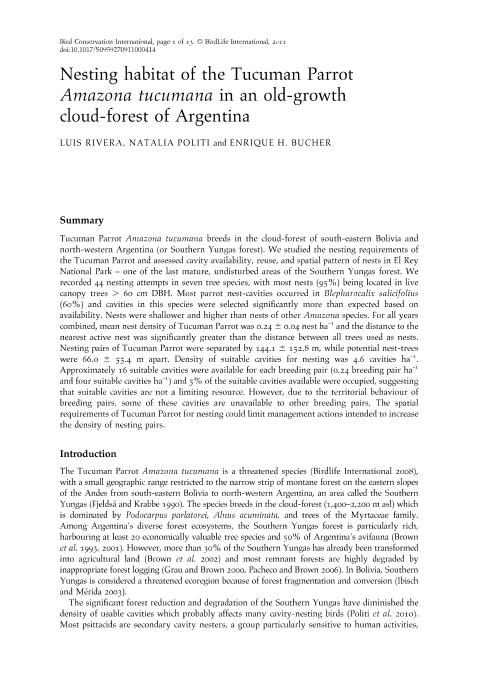Mostrar el registro sencillo del ítem
dc.contributor.author
Rivera, Luis
dc.contributor.author
Politi, Natalia

dc.contributor.author
Bucher, Enrique Hugo

dc.date.available
2023-02-28T12:39:27Z
dc.date.issued
2012-12
dc.identifier.citation
Rivera, Luis; Politi, Natalia; Bucher, Enrique Hugo; Nesting habitat of the Tucuman Parrot Amazona tucumana in an old-growth cloud-forest of Argentina; Cambridge University Press; Bird Conservation International; 22; 4; 12-2012; 398-410
dc.identifier.issn
0959-2709
dc.identifier.uri
http://hdl.handle.net/11336/189049
dc.description.abstract
Tucuman Parrot Amazona tucumana breeds in the cloud-forest of south-eastern Bolivia and north-western Argentina (or Southern Yungas forest). We studied the nesting requirements of the Tucuman Parrot and assessed cavity availability, reuse, and spatial pattern of nests in El Rey National Park-one of the last mature, undisturbed areas of the Southern Yungas forest. We recorded 44 nesting attempts in seven tree species, with most nests (95%) being located in live canopy trees > 60 cm DBH. Most parrot nest-cavities occurred in Blepharocalix salicifolius (60%) and cavities in this species were selected significantly more than expected based on availability. Nests were shallower and higher than nests of other Amazona species. For all years combined, mean nest density of Tucuman Parrot was 0.24 ± 0.04 nest ha-1 and the distance to the nearest active nest was significantly greater than the distance between all trees used as nests. Nesting pairs of Tucuman Parrot were separated by 144.1 ± 152.8 m, while potential nest-trees were 66.0 ± 55.4 m apart. Density of suitable cavities for nesting was 4.6 cavities ha-1. Approximately 16 suitable cavities were available for each breeding pair (0.24 breeding pair ha-1 and four suitable cavities ha-1) and 5% of the suitable cavities available were occupied, suggesting that suitable cavities are not a limiting resource. However, due to the territorial behaviour of breeding pairs, some of these cavities are unavailable to other breeding pairs. The spatial requirements of Tucuman Parrot for nesting could limit management actions intended to increase the density of nesting pairs.
dc.format
application/pdf
dc.language.iso
eng
dc.publisher
Cambridge University Press

dc.rights
info:eu-repo/semantics/openAccess
dc.rights.uri
https://creativecommons.org/licenses/by-nc-sa/2.5/ar/
dc.subject
Tucuman parrot
dc.subject
cloud forest
dc.subject
nest
dc.subject
cavity trees
dc.subject.classification
Conservación de la Biodiversidad

dc.subject.classification
Ciencias Biológicas

dc.subject.classification
CIENCIAS NATURALES Y EXACTAS

dc.title
Nesting habitat of the Tucuman Parrot Amazona tucumana in an old-growth cloud-forest of Argentina
dc.type
info:eu-repo/semantics/article
dc.type
info:ar-repo/semantics/artículo
dc.type
info:eu-repo/semantics/publishedVersion
dc.date.updated
2023-02-26T15:31:38Z
dc.journal.volume
22
dc.journal.number
4
dc.journal.pagination
398-410
dc.journal.pais
Reino Unido

dc.journal.ciudad
Cambridge
dc.description.fil
Fil: Rivera, Luis. Universidad Nacional de Jujuy. Facultad de Ciencias Agrarias. Cátedra de Desarrollo Sustentable y Biodiversidad; Argentina
dc.description.fil
Fil: Politi, Natalia. Universidad Nacional de Jujuy. Facultad de Ciencias Agrarias. Cátedra de Desarrollo Sustentable y Biodiversidad; Argentina. Consejo Nacional de Investigaciones Científicas y Técnicas; Argentina
dc.description.fil
Fil: Bucher, Enrique Hugo. Universidad Nacional de Córdoba. Facultad de Ciencias Exactas Físicas y Naturales. Centro de Zoología Aplicada; Argentina. Consejo Nacional de Investigaciones Científicas y Técnicas; Argentina
dc.journal.title
Bird Conservation International

dc.relation.alternativeid
info:eu-repo/semantics/altIdentifier/doi/http://dx.doi.org/10.1017/S0959270911000414
Archivos asociados
